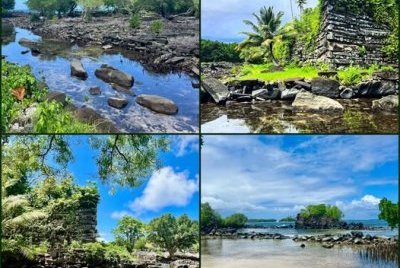
My adventure began at Pohnpei Airport on a Saturday late afternoon, stepping off the famous United Island Hopper with my sights set on Nan Madol tomorrow. The plan was simple: rent a car, explore Pohnpei at my own pace, and lose myself in the shadows of one of the Pacific’s most enigmatic wonders on Sunday. Of course, travel rarely goes according to plan. The rental car mishap was my first hurdle! the local agency had completely forgotten my booking. Thankfully, the airport's free Wi-Fi saved the day, and an hour later, I was finally behind the wheel of a reliable 4WD to my hotel. However, I soon discovered that Micronesia isn’t part of my mobile roaming coverage. With the telecom office closed until Monday, I would have to navigate the island old-school with downloaded maps, instinct, and a dash of blind optimism.
Driving through Pohnpei is a dream in itself. The roads are narrow but scenic, winding through emerald jungles and sleepy coastal villages where locals wave as you pass. After about an hour of driving southeast from Kolonia, I turned off the main road and entered what could only be described as a slow-motion obstacle course. The final stretch leading to Nan Madol was an unpaved dirt road, riddled with potholes and in truly rough shape. Before entering this last section of local road, I paid a $25 entrance fee, and just before the walkway, an additional $3 for land access, as part of local arrangements with private landowners. They actually mentioned there was another $1 fee to be paid at the site, but when I arrived, there was no fee collector in sight.
Crossing the coral stone walkways to reach the site was like walking in the tropical mangrove forest. Nan Madol rises unexpectedly from the mangroves with giant basalt columns stacked in interlocking forms, forming walled temples, tombs, and canals. This was the heart of the Saudeleur Dynasty, that ruled over Pohnpei centuries ago. Since I arrived at high tide, with seawater rising up to my knees and I found myself wading cautiously through the water crossing the small channel to the main sight of Nan Madol, the Nandauwas. I stood silently at the edge of the Nandauwas enclosure and couldn't help but feel the presence of something ancient and powerful. According to legend, the site was built by twin sorcerers who flew the massive stones into place using magic. Whether myth or metaphor, the engineering especially the impressive wall is truly amazing. However, the experience was slightly tempered by the reality around me—plastic bottles, snack wrappers, and discarded garbage littered parts of the pathway and nearby vegetation. It was a disappointing contrast to such a culturally sacred place.
For travelers hoping to visit, timing is everything. The best window is about two hours before or after the lowest tide, when the tidal flats are most accessible, and the light hits the white sand and the basalt walls just right. At that moment, even with the debris around, the ruins feel suspended in time. During my time there, I had the entire site to myself. It was just me, the whispering mangroves, and the quiet lapping of seawater against ancient stone. But as I made my way back toward the walkway, I met a group of four Norwegians and six Chinese tourists, their excitement breaking the stillness of Nan Madol. Clearly, word about Nan Madol had traveled far and wide. Despite its remoteness, the site had carved out a place on the global travel map as No.1 destination of Micronesia.
In the end, visiting Nan Madol was surprisingly straightforward. No guides are required and navigating to the site. With a bit of preparation and downloaded maps, is entirely doable even for independent travelers. Yet, that accessibility is part of the paradox: while it's easy to reach one of Micronesia’s most sacred and significant landmarks, its current state raises concern. The lack of consistent upkeep, combined with mounting litter and informal fee collection, suggests the site isn't being managed with the care it deserves. For a UNESCO World Heritage Site, the contrast between its historical importance and its fragile present feels especially stark. One can only hope that greater awareness will bring stronger efforts to protect this Pacific treasure before time and tide wear it away for good.
More on
Comments
No comments yet.
